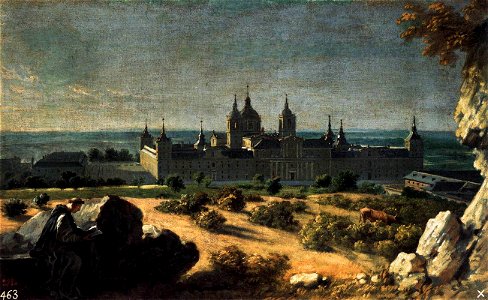General view of the el escorial monastery, located in the community of madrid, (spain). This perspective, which bears great similarities to the one drawn by baldi fifty years earlier, ceased to be real when charles iii ordered the construction of the very long casa de infantes built by villanueva in front of the main façade of the monastery. Thus, the unique dialogue between the surrounding nature and the main façade of el escorial was forever broken, expressive of the hermitical character of this monastery built in the middle of a "desert. " only the two trade houses, facing the north façade, maintained a subordinate relationship to the palace, like the compaña with the monastery. The painter has masterfully reflected the meaning of the filipino community, as it was still preserved then. A hieronymite reads in the middle of the pasture that, from the market itself, extends up the slope of mount abantos, and where the cattle also graze. To the right rise the roofs of the large building, built by francisco de mora for agricultural purposes and the hospitality of the hieronymite community, called la compaña. A corral fenced with a wall, in front of the main façade, is the place where in the 1760s the architect pontones built a small extension and from that angle the casa de infantes is currently built. On the left, behind the trade houses, the doctor's house appears, but the bodyguard barracks ordered to be built by philip v in 1717 is not discernible. Charles ii's stables are hidden by the trade houses, next to which they were built. Houasse has represented in detail the beginning of the avenues that lead to the market, and the parapets of the market in front of the north façade; not so in front of the main one, as they are hidden by the irregular descent of the terrain. It is curious that the painter has chosen a very early morning light, which produces long shadows on the terrain and leaves the main façade in darkness, when he could have shown it in full light under the setting sun (text extracted from sancho, j. L. In: art in the court of felipe v, museo nacional del prado, 2002, pp. 196-197). Object Type: painting. Date: circa 1722. Dimensions: height: 50 cm (19.6 in); width: 82 cm (32.2 in). Medium: oil on canvas. Collection: Museo del Prado. Michel-Ange Houasse - View of the Monastery of El Escorial - WGA11744
Loading...
